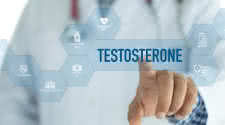Low Testosterone Levels lead to Injuries | Male Hypogonadism

Advanced Science & Training
A recent report, published in the International Journal of Sports Medicine (16:413-17, 1995), focuses on an aspect of hormone function rarely discussed: injury prevention. This case study examined the effects of a continuously low level of testosterone in a 26-year-old soccer
player. He had suffered from recurrent muscle injuries over several years and, when examined, was found to be hypogonadal (low testosterone output). His condition was caused by both extensive athletic activity and a naturally impaired testicular function due to a structural
abnormality. Among his syrup- tows were impaired fertility, low sex drive, a high incidence of muscle strains, and soreness in muscles exercised eccentrically. Eccentric muscle contractions, which occur when towering weights during exercise movements, are thought to he
responsible for most muscle soreness experienced alter training.
Lab tests revealed that this athlete's testosterone levels were especially low after training sessions. During his recovery periods, he also exhibited an adverse testosterone/cortisol ratio, This means that he was producing more cortisol than testosterone, indicative of a
catabolic state. Treatment with physical therapy and other methods of rehabilitation failed to ease his condition. But when he was given Nolvadex (tamoxifen citrate), an estrogen blocker that can increase the release of luteinizing hormone from the pituitary gland and
subsequent testosterone synthesis, he improved rapidly. His testosterone level increased, while his cortisol level dropped. He reported a higher sex drive and an increased sense of wellbeing, and his injury rate decreased dramatically.
The case was complicated by this athlete's preexisting testicular abnormality, but the authors of the study suggest that his extensive training regimen may have added to the problem. This is reflected in his prior cortisol/ testosterone imbalance, known to result from continuous
overtraining. Also entering the picture were a stress syndrome, which further increases cortisol release, and the man's low (7.6%) bodyfat percentage. Such levels are occasionally associated with decreased testosterone synthesis. The authors of this study point out that
anabolic-steroid users show less cortisol elevation after training, less creatine kinase (a muscle enzyme elevated after muscle damage) during the days following training, and experience better subjective recuperation than those eschewing drugs. The high cortisol level in the
hypogonadal soccer player could have led to a weakening of connective tissues, subsequently causing injuries.
One unanswered question, however, is why this man was given Nolvadex (it's a nonsteroidal drug usually prescribed for women who have breast cancer). Since he was found to be clinically deficient in testosterone, a straight testosterone injection might have been a far more
effective treatment for his problem than Nolvadex. Since this man was a competitive athlete, my suspicion is that the researchers didn't want to give him an anabolic steroid from a banned drug list, although he obviously had a legitimate medical indication to be treated with
testosterone. Besides, Nolvadex is also on lists of drugs banned by many international federations. One thing for certain is that as his testosterone level increased, his injury rate diminished.